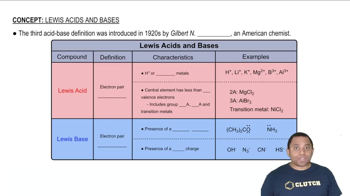Determine the pH of each two-component solution. d. 0.088 M HClO4 and 0.022 M KOH
Ch.17 - Acids and Bases

Chapter 17, Problem 142
Morphine has the formula C17H19NO3. It is a base and accepts one proton per molecule. It is isolated from opium. A 0.682-g sample of opium is found to require 8.92 mL of a 0.0116 M solution of sulfuric acid for neutralization. Assuming that morphine is the only acid or base present in opium, calculate the percent morphine in the sample of opium.
 Verified step by step guidance
Verified step by step guidance1
Determine the number of moles of sulfuric acid (H2SO4) used in the neutralization. Use the formula: moles = molarity (M) imes volume (L). Remember to convert the volume from mL to L by dividing by 1000.
Since morphine accepts one proton per molecule, the number of moles of morphine will be equal to the number of moles of H2SO4 used.
Calculate the molar mass of morphine (C17H19NO3). Add the atomic masses of carbon (C), hydrogen (H), nitrogen (N), and oxygen (O) according to the number of each atom in the formula.
Determine the mass of morphine in the sample by multiplying the number of moles of morphine by its molar mass.
Calculate the percent of morphine in the opium sample by using the formula: (mass of morphine / mass of opium sample) imes 100.

Verified video answer for a similar problem:
This video solution was recommended by our tutors as helpful for the problem above.
Video duration:
7mWas this helpful?
Key Concepts
Here are the essential concepts you must grasp in order to answer the question correctly.
Acid-Base Neutralization
Acid-base neutralization is a chemical reaction where an acid reacts with a base to produce water and a salt. In this context, sulfuric acid (H2SO4) reacts with morphine, which acts as a base, accepting protons. The stoichiometry of the reaction is crucial for determining the amount of morphine present in the opium sample based on the volume and concentration of the acid used.
Recommended video:
Guided course

Lewis Acids and Bases
Molarity and Moles
Molarity (M) is a measure of concentration defined as moles of solute per liter of solution. To find the number of moles of sulfuric acid used in the neutralization, the molarity and volume of the acid solution must be converted into moles using the formula: moles = Molarity × Volume (in liters). This calculation is essential for determining how many moles of morphine were neutralized by the acid.
Recommended video:
Guided course

Molarity
Percent Composition
Percent composition is a way to express the concentration of a specific component in a mixture, calculated as the mass of the component divided by the total mass of the mixture, multiplied by 100. In this problem, once the moles of morphine are determined, the mass can be calculated and then used to find the percent composition of morphine in the opium sample, providing insight into its purity.
Recommended video:
Guided course

Mass Percent Calculation
Related Practice
Textbook Question
Textbook Question
Write net ionic equations for the reactions that take place when aqueous solutions of the following substances are mixed: a. sodium cyanide and nitric acid b. ammonium chloride and sodium hydroxide c. sodium cyanide and ammonium bromide d. potassium hydrogen sulfate and lithium acetate e. sodium hypochlorite and ammonia
Textbook Question
The pH of a 1.00 M solution of urea, a weak organic base, is 7.050. Calculate the Ka of protonated urea.
Textbook Question
Lactic acid is a weak acid found in milk. Its calcium salt is a source of calcium for growing animals. A saturated solution of this salt, which we can represent as Ca(Lact)2, has a [Ca2+] = 0.26 M and a pH = 8.78. Assuming the salt is completely dissociated, calculate the Ka of lactic acid.
